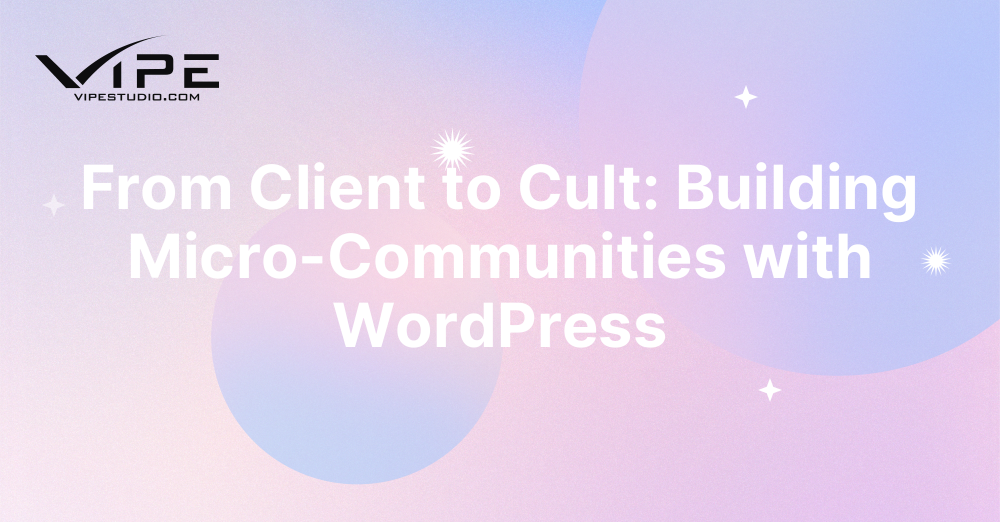09.10.2025
WordPress Development
From Client to Cult: Building Micro-Communities with WordPress
READING TIME: MIN
Table of Content
Introduction: Beyond Websites to Belonging
Websites are often framed as digital storefronts-places to showcase services, publish content, and attract leads. But in the age of digital tribes and niche audiences, websites can serve a far deeper purpose. They can foster micro-communities, transforming passive clients into active participants and even loyal advocates. WordPress, with its flexible ecosystem and extensibility, is uniquely positioned to support this transformation. The journey from client to cult is not about manipulation but about cultivating belonging, identity, and shared purpose through intentional design choices.
The Concept of Micro-Communities
A micro-community is a small, highly engaged group of individuals who interact around a specific interest, service, or value. Unlike massive platforms where attention is scattered, micro-communities thrive on intimacy and interaction. They are characterized by trust, mutual recognition, and shared rituals. In business terms, they convert customers into ambassadors who amplify the brand far beyond transactional relationships.
From a technical standpoint, micro-communities rely on platforms that encourage participation rather than passive consumption. WordPress provides a foundation for this by enabling forums, membership portals, and content hubs that bring people together around a central purpose.
Why WordPress Is Suited for Community-Building
WordPress is not only a content management system-it is an infrastructure for participation. Its open-source nature, plugin ecosystem, and adaptability make it a natural choice for community-oriented projects. Developers can integrate membership plugins, discussion boards, gamification systems, and even learning management tools without needing to reinvent the wheel.
For instance, BuddyPress and bbPress allow community features to be embedded directly into a WordPress site. Advanced membership tools like MemberPress or Restrict Content Pro transform websites into gated communities with tiered access. These features provide the scaffolding to move from a simple client relationship to an engaged, participatory culture.
From Transactional to Relational Design
Traditional websites focus on transactions: buying products, submitting forms, booking services. To build a micro-community, design must shift toward relationships. This involves creating multiple touchpoints where members can interact with each other-not just the brand. Comment sections, user profiles, discussion threads, and direct messaging all create opportunities for connection.
The psychology of community-building lies in recognition and reciprocity. A client who feels seen, heard, and valued is far more likely to transition into an advocate. WordPress allows developers to integrate these relational features while tailoring them to the brand’s identity. A generic client portal can evolve into a social hub where members identify as part of something larger than themselves.
The Role of Content in Fostering Belonging
Content is the glue that binds communities together. A micro-community does not thrive on static product pages-it thrives on shared knowledge, insights, and experiences. Regular blog posts, discussion prompts, webinars, and curated resources provide the scaffolding for interaction. When delivered consistently, content becomes a ritual that members anticipate, reinforcing their sense of belonging.
Content personalization also plays a role. WordPress plugins that adapt content delivery based on user roles or activity patterns ensure that members feel the site speaks directly to them. This level of attention signals care, which fosters loyalty. The transition from client to cult is accelerated when members feel that their voices and needs shape the ecosystem they inhabit.
Gamification and Rituals in Micro-Communities
Human psychology thrives on recognition and achievement. Gamification introduces badges, points, and rewards that acknowledge participation. While it may sound superficial, these mechanisms create rituals that members grow attached to. Rituals, whether weekly challenges, monthly Q&A sessions, or annual meetups, become cornerstones of identity.
WordPress’s flexibility makes gamification easy to implement. Plugins like GamiPress or myCRED allow administrators to create layered recognition systems, encouraging members to engage more deeply. In the long run, these rituals and rewards transform casual users into active community leaders.
Balancing Exclusivity and Openness
Micro-communities thrive on balance. Too much exclusivity risks alienation; too much openness risks dilution. Membership-based access, premium tiers, or hidden forums can create a sense of privilege and belonging. At the same time, open resources, public-facing blogs, or free trials ensure that newcomers have a pathway into the culture. WordPress supports both ends of this spectrum, enabling administrators to decide how permeable or exclusive the community should be.
Many organizations experiment with hybrid models: free content to attract a broad audience, and premium spaces to deepen commitment. These models echo the natural progression from client to cult-starting with access, building trust, and eventually nurturing deep loyalty.
The Technology of Trust
Trust is fragile, and communities collapse without it. Security, privacy, and data control play a central role in maintaining that trust. WordPress administrators must implement SSL, enforce two-factor authentication, and secure data handling practices. A single breach can erode years of community-building.
This is why organizations sometimes look for professional WordPress expertise when scaling their communities. Beyond functionality, trust in the system itself reassures members that their participation is valued and safe. Transparency-such as clear terms of use and responsive moderation-reinforces this foundation.
Case Studies: Communities in Action
Examples of WordPress-based micro-communities abound. Independent educators create membership sites where students support each other in forums and share resources. Non-profits launch communities where volunteers coordinate efforts and share success stories. Niche hobbyists create platforms where enthusiasts exchange tutorials, project files, and event updates. In each case, WordPress’s adaptability allows the site to reflect the identity of the community, not just the brand behind it.
In more advanced setups, organizations layer in integrations with CRMs, e-learning platforms, or even live-streaming services. These integrations expand the community’s reach while still grounding it in the central hub of a WordPress site. Developers who experiment with such models often treat their websites less as static products and more as evolving ecosystems.
Challenges in Sustaining Micro-Communities
While the transition from client to cult is enticing, sustaining micro-communities presents real challenges. Moderation, content production, and engagement require ongoing investment. Without dedicated leadership, communities risk stagnation. WordPress provides the tools, but it cannot manufacture the human energy required to keep members involved.
Another challenge lies in avoiding echo chambers. Healthy communities encourage diversity of thought, but overly closed groups risk reinforcing narrow perspectives. Administrators must consciously design spaces that promote inclusion and dialogue. For some, this involves working with a WordPress agency to create moderation strategies, scalable content systems, and growth frameworks.
Conclusion: Cultivating Loyalty Through Community
Transforming clients into community members-and eventually into loyal advocates-is one of the most powerful strategies in the digital era. WordPress, with its rich ecosystem, offers the infrastructure to build these micro-communities effectively. But the technology is only the beginning. Success lies in intentional design, trust-building, and consistent nurturing of relationships. The result is not just a website but a living, evolving space where people feel they belong. This is the essence of moving from client to cult-a shift from transactions to tribes, from service delivery to shared identity.
Key takeaways
- Micro-communities thrive on intimacy, interaction, and shared identity.
- WordPress offers plugins and tools that make community features accessible.
- Content, gamification, and rituals drive engagement and loyalty.
- Trust and security are critical foundations for community sustainability.
- Balance between openness and exclusivity shapes the health of a community.
- Communities require continuous leadership and intentional design to flourish.
More on The Topic
- The Admin UX That Shapes Decisions
- Scaling WordPress Without Losing Culture
- WordPress 6.9 “Gene”: What This Release Really Changes
- Managing Gutenberg Chaos at Scale
- The Real Difference Between Managed and Developer-Oriented Hosting
The content of this website is copyrighted and protected by Creative Commons 4.0.



